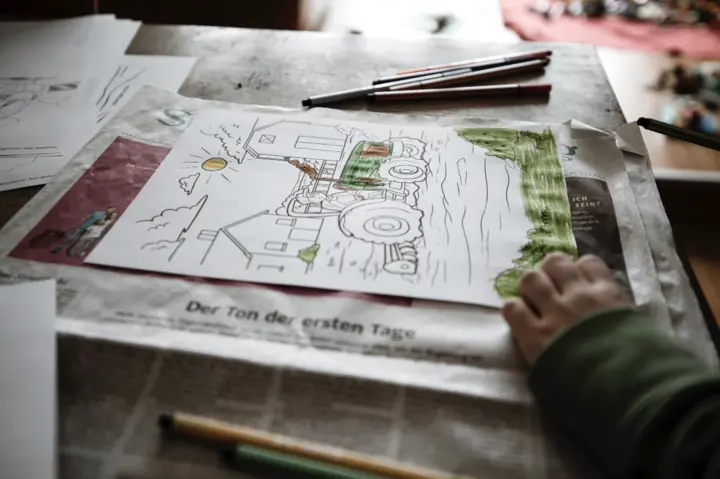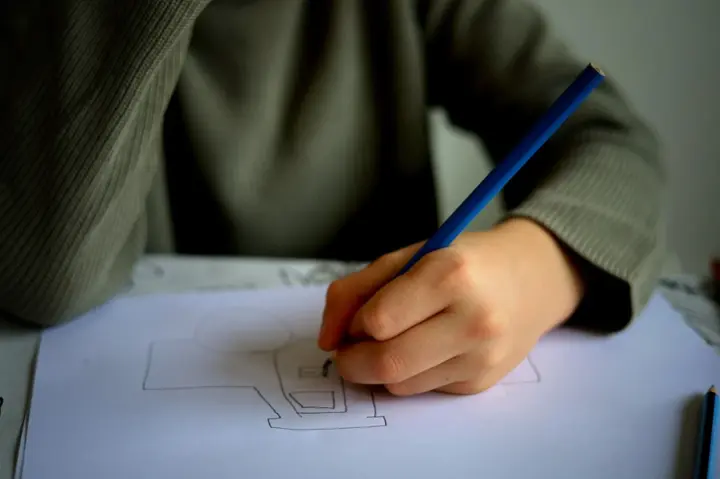Your child's drawings have multiple meanings: let's get to know them
Children's drawings may seem to some that they are not meaningful at all and some see them as just scribbles with which they can occupy the child's time. But here to tell you that children's drawings are rarely devoid of meaning or meaning. Children's drawings vary according to the child's age, even a child who is only one year old can draw even random lines.
Many psychiatrists around the world have studied children's drawings in different stages and divided them into age stages, and this article will introduce you to those age stages, the characteristics of child drawings at each stage, and some symbols through which you can identify some of the child's feelings. The child projects his feelings on his drawings and thus achieves harmony by venting those feelings.
Recommend
The importance of identifying these age stages and the characteristics of their drawings lies not only in understanding the drawings, but also in diagnosing some cases that need specialized intervention such as mental delay, various learning difficulties and psychological problems of all kinds.
Stages of children's drawings

A two-to-four-year-old child goes through the scribble stage: it is the child's way of expressing his presence, starting as random lines. You'll notice that he doesn't care about the boundaries of the paper, so while planning he sometimes goes out of the paper. Scribbling or scribbling is random from the age of one and a half to two years and then becomes somewhat organized scribble or scribbles from the age of two to four years. At this point, he tries to separate the colors, begins to draw the head in a circular shape and begins to draw overlapping lines. At that stage, your child regulates his feelings and can separate himself from the world around him. He begins to control his behaviors as well. The child begins to name his drawings and draw symbols and here he begins to develop learning and thinking skills "named scrabble".
A child from 4 to 7 years old goes through the descriptive drawing stage: he starts drawing unsophisticated shapes and head drawings appear to express people. You will notice that your child outlines his drawings and the color is clearly visible in those boundaries. Drawings are often in the middle and your child is busy drawing individuals and relationships like drawing family members or friends together. The child at that stage tries to be understandable to others.
A child from 7 to 9 years old goes through the stage of building diagram: he notices the multitude, clarity, diversity and importance of symbols. You will notice that your child is distributing his drawings in the page so that they are divided into top, middle and bottom sections such as drawing a garden, individuals and sky. At this stage, the child's mental abilities develop and he begins to better understand the relationships. The child understands laws and order and is able to understand and relate events and understand the relationships between objects.
Children who are late and have difficulties often stop developing their fees at that stage and some develop through guidance but especially expressed them.
Your child expresses his inner world in one of three ways, either by overshadowing over the same area or by deleting details such as drawing a person without an ear, hands, or eyes, and finally, by raising the drawings to the top of the page.
A child from 7 to 11 years old is at the beginning stage of realistic painting: you will find that the drawings are deep and you will notice an evolution in his expression of the surrounding reality and his use of natural colors. You will notice the growth of observation and scrutiny in the child and the drawings are dominated by shading, ellipses, depth and drawing corners.
An 11 to 14 year old child goes through the stage of realistic drawing: drawing the environment around him, reality as it is. You will notice his awareness of characters and events clearly and his observation of the smallest details. Adolescence where he thinks about himself and others and his desires, identities and needs and you will notice that his drawings from his own perspective, how he sees himself and others.
Analysis of some common drawings and techniques:

The child should be asked what it means to draw a particular thing, as these symbols sometimes differ from child to child"
Drawing from left and right direction: expresses the child's need for tenderness and care from his parents.
The drawing of the mother is very large in size and the father is small: the child expresses the control of his mother at home and the weakness of the father.
The child draws faces ugly: expresses the child's hatred for that person as well as family disputes in the event that the characters are ugly face parents.
Drawing faces from the side: The child thus expresses the difficulty of establishing relationships with these characters.
Drawing a sad face: expresses the child's sadness and difficulty in dealing with others.
The child's drawing of faceless characters: indicates that others do not feel the child's presence.
The child's drawing of the face without eyes: indicates that the child does not prefer to mix with the other two. If the child draws the eyes behind glasses, this indicates that the tuff is withdrawn, unless the person drawn is already wearing glasses.
Drawing a person with big hands: It may mean that the child steals something, while drawing a large head may mean that the child is troubled and busy thinking about multiple things and a shy child draws a small head.
Drawing a child as a human being without hands or legs: it may mean that the child is confused and does not know how to behave.
Children who draw only at the bottom of the sheet have a low vision of themselves and suffer from insecurity. Conversely, the concentration of cartoons at the top of the page means excessive self-esteem.








